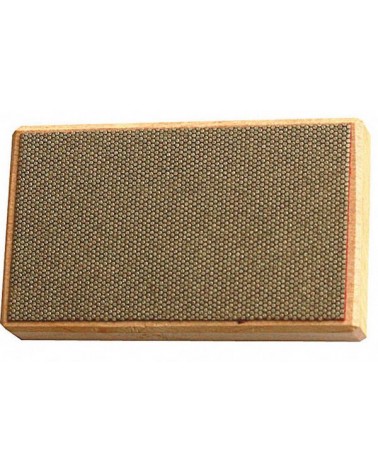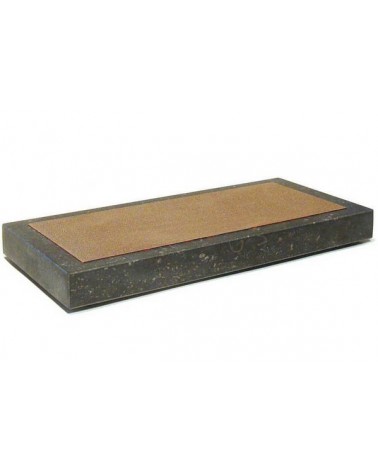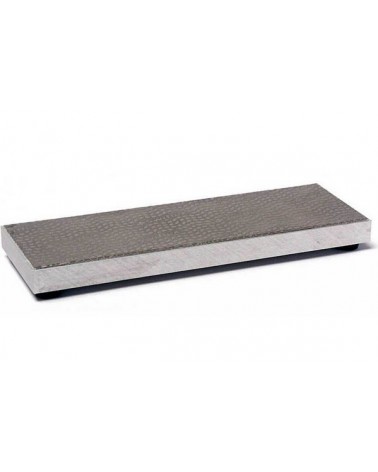We deliver fast - Postage free from 150 € (DE) - 60 days right of return - mail@bildhau.de - Tel.: +49 (0)221-99874700
Sculptor's chisel sharpened by hand
Point chisels, flat chisels and claw chisels, especially those made of forged steel, must be sharpened regularly during work, between once and four times per working hour, depending on the hardness and condition of the stone. With carbide chisels, resharpening is usually required much less frequently.To find out how to sharpen your chisels by hand, read here
--==Footer==
You can easily sharpen both forged steel and carbide chisels by hand. A diamond sharpening block is suitable for both types of chisel. You can also sharpen forged steel chisels with a bench stone. Since diamond sharpening blocks are also available in a very small format, you can easily take them directly to your workplace when you are working outdoors, for example, or when you are on the road. Bench stones are quite heavy, which is why they are more likely to be used in the studio or workshop.
Bank stones for sharpening forged steel tools
The big advantage of a bench stone is its weight: it does not slip when grinding and you have both hands free to guide the tool. It is also very cheap compared to diamond blocks. The bench stones from bildhau are made of Oberkirchen sandstone.The longer a bench stone is, the better, because the longer the path you can drag the chisel over the stone and the less easily you change the shape of the tool when sharpening it. A stone of about A4 size is already a good size. The bench stone is basically used with water. If you work all day and have to sharpen your tools again and again, it is best to wet the stone well twice during the day. Sharpening with the bench stone does not usually take longer than machine sharpening.
How do you go about sharpening forged steel tools?
There will be many answers to the question of how and in what shape it is best to grind a chisel. We recommend the following:A point chisel is best used when the tip is as central as possible, the sides are slightly convex and the edges are sharp. To maintain or restore this shape when sharpening, hold the point chisel with one hand and place the other hand flat on the front of the chisel. To sharpen, pull the iron with light pressure of the flat hand over the entire length of the bench stone. Push the iron back without applying any pressure. For the convex shape, pull the back end of the iron very slightly upwards while sharpening. Otherwise, the surfaces of the iron should lie smoothly on the stone so that the edges remain intact or are sharpened as well. For an even sharpening result, it is helpful to count the sharpening strokes, e.g. ten strokes per side of the chisel. This keeps the tip of the chisel in the middle!
Flat irons or lettering irons are not ground into a convex shape but as narrow and straight as possible, i.e. the iron is guided evenly over the bench stone and pressure is exerted on both the forward and backward movement. New flat irons often have a small bevel, i.e. a chamfer at the front. This bevel serves mainly to protect the new iron and does not have to be retained when sharpening.
Claw chisels are sharpened in the same way as flat chisels. With forged chisels, the spaces between the teeth cannot be sharpened.
When sharpening with the bench stone, it is important to always use the entire length of the stone for the benefit of the chisels. To preserve the stone for a long time, it is advisable to always place the chisels in different places so that no grooves form.
If grooves do form on the bench stone, the stone must be trued to achieve an optimum sharpening result again.
Diamond sharpening blocks for sharpening forged steel & carbide chisels
Diamond sharpening blocks are an alternative to the bench stone. They are man-made and have different supports: wood, stone or aluminium. Each carrier material offers different advantages. Wood is light, aluminium rusts and does not break, stone is heavy and thus lies well on a workbench or in the hand. With a diamond sharpening block, you can also sharpen carbide chisels very quickly. It is suitable for both dry and wet grinding.Diamond sharpening blocks are available in different sizes and grits. If you travel a lot or always want to have your abrasive with you, a 70 x 40 mm diamond sharpening block on a wooden carrier in pocket format is best. Those looking for something more for the studio will probably opt for a larger format and a stone base.
All diamond sharpening blocks have one thing in common: they are long-lasting, sharpen tools reliably and evenly and do not need to be dressed. Diamond sharpening blocks are available from bildhau in different grit sizes, with a 120 grit being suitable for quick sharpening and a 200 grit being universally applicable. The 400 or 800 grit blocks are more suitable for honing woodworking tools.



